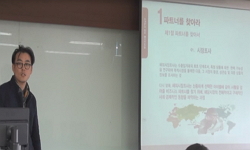본 연구에서는 상재하중을 적용한 굴착모형실험을 통하여 상재하중 적용으로 인한 굴착단계별, 벽체강성 및 지반조건에 따른 토류벽체의 수평변위, 배면지반 지표침하, 토류벽체에 적용되...
http://chineseinput.net/에서 pinyin(병음)방식으로 중국어를 변환할 수 있습니다.
변환된 중국어를 복사하여 사용하시면 됩니다.
- 中文 을 입력하시려면 zhongwen을 입력하시고 space를누르시면됩니다.
- 北京 을 입력하시려면 beijing을 입력하시고 space를 누르시면 됩니다.

상재하중을 받는 토류벽체의 거동에 관한 모형실험 연구 = Model Test for the Behavior of Retaining Walls Under Surcharge Load
한글로보기https://www.riss.kr/link?id=A105845352
-
저자
정온수 ; 허경한 ; Jung. On-Su ; Huh. Kyung-Han
- 발행기관
- 학술지명
- 권호사항
-
발행연도
2005
-
작성언어
-
-
주제어
상재하중 ; 침하 ; 토류벽체 ; 배면지반 ; 벽체강성 ; surcharge load ; settlement ; retaining wall ; backfill ; wall stiffness
-
KDC
530
-
등재정보
KCI등재
-
자료형태
학술저널
-
수록면
49-58(10쪽)
- 제공처
-
0
상세조회 -
0
다운로드
부가정보
국문 초록 (Abstract)
본 연구에서는 상재하중을 적용한 굴착모형실험을 통하여 상재하중 적용으로 인한 굴착단계별, 벽체강성 및 지반조건에 따른 토류벽체의 수평변위, 배면지반 지표침하, 토류벽체에 적용되는 토압변화 및 분포에 대하여 실험결과치, 이론치 및 현장자료 분석치와 상호비교, 분석하여 상재하중 적용에 의한 영향을 규명하였다. 그 결과 상재하중이 적용된 모형지반에서의 지표침하곡선 형태는 상재하중 미 적용시 지표침하 곡선형태의 정규확률 분포곡선과 달리 상재하중 중앙 부분이 최대 침하를 일으키는 포물선 형태의 침하를 보이고 있으며, 굴착단계별 상재하중 적용으로 인한 벽체최대수평변위는 최종굴착시에 0.8H(보:굴착깊이) 지점에서 벽체의 최대수평변위가 발생하였으며, 상재하중 적용에 따른 벽체변위량의 증가범위는 벽체상부로부터 하중이격거리에 2배의 깊이까지 증가범위를 보였다. 또한, 굴착단계별 지표면의 침하로 인한 기초판의 각 변위는 최종단계에서의 각 변위가 가장 크게 발생하였고, 벽체강성별로는 두께 4mm(유연계수 <TEX>${\rho}\;:480m^3/t$</TEX>) 벽체가 두께 9mm(유연계수 <TEX>${\rho}\;: 40m^3/t$</TEX>)보다 최대 3배 이상 발생하고 있어 벽체강성의 영향이 매우 큼을 알 수 있다.
다국어 초록 (Multilingual Abstract)
The purpose of this study is to closely examine the influence of the surcharge load applied to the retaining wall through some model tests, in which wall stiffness in each stage of excavation, horizontal displacement of the retaining wall and surface ...
The purpose of this study is to closely examine the influence of the surcharge load applied to the retaining wall through some model tests, in which wall stiffness in each stage of excavation, horizontal displacement of the retaining wall and surface displacement of the backfill according to wall stiffness and ground conditions, and change and distribution of the earth pressure applied to it were measured and their values were produced, then these values were mutually compared with their theoretical values and their values after analysis of the data obtained at the field, and they were analytically studied, in order to closely examine the influence of the surcharge load applied to the retaining wall. Findings from this study are as follows: The shape of ground surface settlement curve on the model ground under surcharge load, different from the distribution curve of regular probabilities which is of a shape of ground surface settlement under no surcharge load, appears in that settlement in an arching shape shows where the center part of surcharge load shows the maximum settlement. In examining the maximum horizontal displacement with the surcharge load applied to each stage of excavation, it occured at the point of 0.8H(excavation depth) when finally excavated. Regarding the range in which the displacement of the retaining wall increases according to application of surcharge load, the increment of displacement showed till the point of depth which is of two times of the distance of load from the upper part of the wall. Also since each displacement of the foundation plate caused by the ground surface settlement according to each stage of excavation occured most significantly at the final stage. Also since regarding wall stiffness, the wall of its thickness of 4mm(flexible coefficient <TEX>$p:480m^3/t$</TEX>), produced maximum 3 times of wall stiffness than its thickness of 9mm(flexible coefficient <TEX>$p: 40m^3/t$</TEX>), it was found out that influence of wall stiffness is so significant.
동일학술지(권/호) 다른 논문
-
부산 해성 점토의 일축압축강도 특성 및 교란도에 관한 연구
- 한국방재학회
- 김병일
- 2005
- KCI등재
-
지리정보시스템(GIS)을 이용한 도심지 내의 위해시설 관리시스템 구축에 관한 연구
- 한국방재학회
- 함은구
- 2005
- KCI등재
-
- 한국방재학회
- 이창수
- 2005
- KCI등재
-
- 한국방재학회
- 최종인
- 2005
- KCI등재




 ScienceON
ScienceON 스콜라
스콜라




